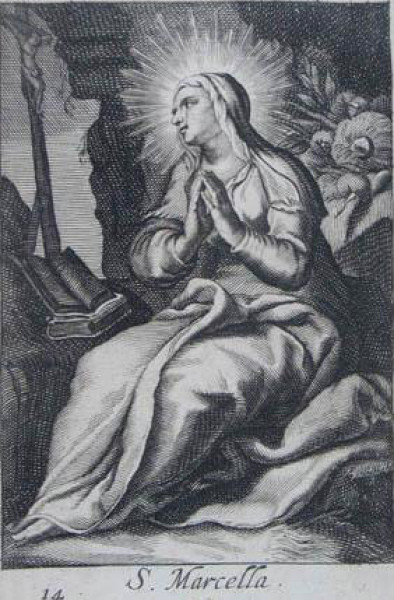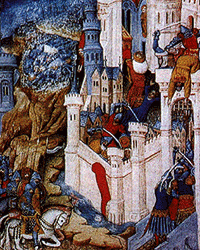Marcella (approx. 325–410) – a curious erudite from Aventine Hill

Saints Marcella and Jerome, altar painting, fragment, Roman school?, 18th century, Church of Santi Bonifacio e Alessio

Saints Marcella and Jerome, altar painting, Roman school?, 18th century, Church of Santi Bonifacio e Alessio

Church of Saint Marcella in the district of Ostiense

Saint Marcella, pic. Wikipedia
We do not know much about her, but the information which we do have paint a picture of an exceptional woman, thirsty for knowledge, intelligent, and hard-working. Her main claim to fame was bringing together similarly-thinking women, who enthusiastically analyzed the complexity of the Bible, its ambiguity, and often its contradictions. And perhaps that is why, the then pope, Damasus – a frequent guest at Marcella’s home – entrusted Jerome with a new translation of the Holy Scriptures, since he also had to notice the problems the faithful had with the interpretation of the Bible.
We do not know much about her, but the information which we do have paint a picture of an exceptional woman, thirsty for knowledge, intelligent, and hard-working. Her main claim to fame was bringing together similarly-thinking women, who enthusiastically analyzed the complexity of the Bible, its ambiguity, and often its contradictions. And perhaps that is why, the then pope, Damasus – a frequent guest at Marcella’s home – entrusted Jerome with a new translation of the Holy Scriptures, since he also had to notice the problems the faithful had with the interpretation of the Bible.
However, before we move on to these issues, let us shed some light on Marcella. She was a member of the famous Marcelli family, and was a daughter of a Christian, Albina; her father had died when she was a child. Most likely as a teenager (unfortunately we do not know the exact date of her birth), in 340 she met the bishop Athanasius of Alexandria who came to Rome – an exile looking for the support of the bishop of Rome, a vehement opponent of Arianism, and in addition a skilled writer and speaker. He was a guest at Albina’s house and it was probably he who first told Marcella about the pious ascetics who lived in the desert. She also probably read the very popular at that time among Christian communities The Life of St. Anthony, written by Athanasius. The influence this book had on her on her road to asceticism can be testified to by the fact, that she convinced Jerome - the future interpreter of the Bible to travel to the Syrian desert.
Marcella lived along with her mother on Aventine Hill, in a villa, which was identified during archeological works. It was located in a present-day park, between the Churches of Santa Sabina and Santi Bonifacio e Alessio. There, among the silence, sounds of fountains, and greenery, Marcella spent nearly all of her life, since only a few short months after marrying she became a widow, and from that moment on she decided to live a solitary life. She devoted herself to prayer, moderate fasting, social life, and elegant clothing no longer interested her. Her main passion was the analysis of the Bible. Quickly she noticed (most likely) the imperfection of the Greek and Old Latin translation, confronting them with the Hebrew original, and discovered numerous discrepancies. She began learning Hebrew, while her house was regularly visited by the clergy and deeply religious women aristocrats (such as Paula along with her daughter Eustochium, Lea, Fabiola, Furia, Melania the Elder). Just as she, these women were eager to understand the biblical message. Participation in the Eucharist and the popular at that time visits to tombs of martyrs apparently did not fulfill the expectations of the ambitious women. They wanted to know and understand the Scriptures, which they read together and whose fragments they committed to memory. They asked about the meaning of Hebrew words that were not translated into Greek, or what kind of robes were worn by Jewish priests; they asked about women in the Bible (Susanna, Deborah), about the exegesis of parts of Psalms, or their comments. They were interested both in lexical and translator matters. Marcella was their leader, who due to her age, passion, and education (familiarity with ancient literature, Greek, and Hebrew) boasted the best philological, religious, and biblical preparation. Therefore, it should come as no surprise, that when Jerome, who was considered one of the best experts on the Bible, came to Rome (382) he quickly found faithful admirers and students among these women. He was also a frequent guest at Marcella's home on Aventine Hill, He considered her to be curious, intelligent, and tireless in her search erudite.
Marcella, her stepdaughter Principia, and the group of women who accompanied them – mainly declared virgins and widows from the best houses – since the arrival of Jerome exhibited increasing strictness. And although this commune did not yet have written rules and formal organizational structures, numerous authors see in it the beginnings of female monastic life in the Western world. This was not looked upon favorably in the city and led to rumors, especially since Marcella despite the requests of her mother rejected an offer of marriage from the Roman consul (Naeratius Cerealis). Rome was still predominantly pagan, but even among Christians the propaganda of asceticism, celibacy, and rejection of marriage, which Jerome referred to as “perfect monogamy”, did not find many supporters. There was widespread criticism against “disgusting monkish rabble made up of simpletons and charlatans, propagating some strange Greek customs”. Jerome also felt the burden of slander and calumnies which spread about him. Men ridiculed his company of ladies, which he mentions in one of his letters: “If men had asked me about the Holy Scriptures I would not be speaking to women". However, men did not want to listen to him or take advice from him. Impatient with this fact he defended himself writing: “Where men have failed, God has called upon women to accomplish great things”, which was a reference to women in the Bible, but he probably thought about Marcella’s group and especially of her.
The rumors subsided when Jerome left Rome in 385, along with Paula and Eustochium to devote himself to monastic life in Bethlehem. Marcella remained. In the following years, she corresponded with Jerome, mainly on biblical issues. In one of his letters, Jerome in frustration accuses her of writing about nothing else and immediately starts asking questions about the exegesis of the Holy Bible. He wrote: "So yesterday presenting an issue, you demanded that I immediately write back as if I had been one of the Pharisees as if I was some kind of an intermediary or an arbiter when an argument arises about a Hebrew word”.
The demanding and impatient Marcella was, as it would seem, an incisive and competent interlocutor for Jerome, an expert on the Scriptures who rivaled him. Their correspondence, similarly to Jerome’s letters exchanged with other women from this group, shows us the level of the debate, makes us aware of the complexity of the biblical issues that they dealt with, how they desired knowledge and how complicated their questions were. It was they who stimulated the future Doctor of the Church to work, which he freely admits in one of his letters to Marcella: “You turn to me with serious questions, and in questioning, you stimulate my mind which has frozen from inactivity”.
Thanks to one preserved letter from Paula to Marcella we can also become aware of her other qualities – gentleness and patience. Paula tries to convince her to come to Bethlehem, seeking support in the hardships, that they experience together with Jerome. However, Marcella did not come.
And what was happening in Rome at that time? The bible study group fell apart, some women married, others devoted themselves to asceticism, others still to charity. Marcella (despite being a woman) became an expert not only on biblical matters. We know that she took part in the ideological dispute regarding Origen and Novatian, which at that time occupied the most important Church authorities in the city on the Tiber. Jerome wrote: "If after my leaving, there arose a dispute over some testimony in the Holy Scriptures, it was she who was asked to be the judge”; then adding that “she answered the questions in such a manner than even her own views she did not call her own, but either mine or somebody else's”. Therefore he praised Marcella’s modesty, most likely remembering the words of Saint Paul: “I do not permit a woman to teach”.
Marcella left Rome with Principia around 383 and hid in her rural residence, wherefrom she sent letters to Jerome, impatiently awaiting his answers. She returned to the Eternal City when Alaric invaded Italy. She died in the year 410, reaching the age of nearly eighty after the Visigoths had entered the city and plundered her house.
Thirty-nine letters from Jerome to the women from „Marcella's group" have been preserved, most of them, eighteen, are addressed to her. Unfortunately only Jerome’s letters were preserved, Marcella’s letters – probably considered as less relevant – were lost. The later Doctor of the Church wrote a panegyric in her honor, which he included in his letter (Letter 127) to Principia. It is from this letter that we get most of our knowledge about her.
She became a saint but remains rather unknown. Was the reason her work – not fit for a woman, independence in her judgments, the ability to judge? Most likely.
















